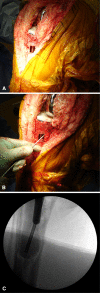Liner exchange and bone grafting: rare option to treat wear & lysis of stable TKAs
- PMID: 20809171
- PMCID: PMC3008882
- DOI: 10.1007/s11999-010-1521-3
Liner exchange and bone grafting: rare option to treat wear & lysis of stable TKAs
Abstract
Background: Liner exchange and bone grafting are commonly performed for wear and osteolysis around well-fixed modular acetabular components that otherwise would require structural allografting and revision THA. However, liner exchange in the face of substantial lysis around TKA has been performed rarely with reports of failure rates of up to 25% at 3 year followup.
Questions/purposes: We therefore evaluated the technique of liner exchange and bone grafting for cases of wear and extensive osteolysis around TKAs in which the components were well-fixed and well-aligned to determine (1) rerevision rates; (2) fate of the bone graft; (3) radiographic loosening rates; and (4) functional scores.
Methods: We retrospectively reviewed 22 patients (25 knees) who underwent revision TKA with exchange of the modular polyethylene insert and bone grafting in cases with well-fixed components and large areas of osteolysis (up to 54 cm(2) on a single projection) at the time of revision. The average area of osteolysis was 21 cm(2) and 10 cm(2) on the AP projection of the femur and tibia, respectively. On the lateral projection, the average area of osteolysis for the femur and tibia was 22 cm(2) and 9.3 cm(2). Minimum clinical and radiographic followup was 22 and 22 months (average, 61 and 59; range, 22-142 and 22-130, respectively).
Results: One of the 25 knees was revised for aseptic loosening or recurrence of osteolysis. On radiographs, 84.6% and 70% of femoral and tibial osteolytic lesions, respectively, showed evidence of complete or near complete graft incorporation. The remaining lesions showed evidence of partial graft incorporation with the exception of one tibial lesion, which was in the revised case. All other components were well fixed with no evidence of radiographic loosening.
Conclusions: In this selected series of cases with extensive osteolysis around well-fixed and well-aligned TKAs, liner exchange and bone grafting provided durable midterm results with extensive graft incorporation.
Level of evidence: Level IV, therapeutic study. See Guidelines for Authors for a complete description of levels of evidence.
Figures


Similar articles
-
The surgical options and clinical evidence for treatment of wear or corrosion occurring with THA or TKA.Clin Orthop Relat Res. 2014 Dec;472(12):3674-86. doi: 10.1007/s11999-014-3652-4. Clin Orthop Relat Res. 2014. PMID: 25024023 Free PMC article. Review.
-
Modular insert exchange in knee arthroplasty for treatment of wear and osteolysis.Clin Orthop Relat Res. 2007 Nov;464:132-7. Clin Orthop Relat Res. 2007. PMID: 18062046
-
Is There a Benefit to Highly Crosslinked Polyethylene in Posterior-stabilized Total Knee Arthroplasty? A Randomized Trial.Clin Orthop Relat Res. 2016 Jan;474(1):88-95. doi: 10.1007/s11999-015-4241-x. Clin Orthop Relat Res. 2016. PMID: 25762016 Free PMC article. Clinical Trial.
-
Wear and lysis is the problem in modular TKA in the young OA patient at 10 years.Clin Orthop Relat Res. 2011 Jan;469(1):41-7. doi: 10.1007/s11999-010-1429-y. Clin Orthop Relat Res. 2011. PMID: 20568028 Free PMC article.
-
Wear and loosening in total knee arthroplasty: a quick review.J Knee Surg. 2015 Apr;28(2):139-44. doi: 10.1055/s-0034-1398375. Epub 2014 Dec 24. J Knee Surg. 2015. PMID: 25539400 Review.
Cited by
-
The surgical options and clinical evidence for treatment of wear or corrosion occurring with THA or TKA.Clin Orthop Relat Res. 2014 Dec;472(12):3674-86. doi: 10.1007/s11999-014-3652-4. Clin Orthop Relat Res. 2014. PMID: 25024023 Free PMC article. Review.
-
Modular versus nonmodular tibial inserts in total knee arthroplasty: what are the differences?Ann Transl Med. 2017 May;5(10):225. doi: 10.21037/atm.2017.02.25. Ann Transl Med. 2017. PMID: 28603740 Free PMC article. No abstract available.
-
Durability of a cruciate-retaining TKA with modular tibial trays at 20 years.Clin Orthop Relat Res. 2013 Jan;471(1):109-17. doi: 10.1007/s11999-012-2401-9. Clin Orthop Relat Res. 2013. PMID: 22669547 Free PMC article.
-
Treatment for Wear and Osteolysis in Well-Fixed Uncemented TKR.ISRN Orthop. 2013 Feb 11;2013:398298. doi: 10.1155/2013/398298. eCollection 2013. ISRN Orthop. 2013. PMID: 24959358 Free PMC article.
-
The role of isolated polyethylene exchange in total knee arthroplasty.EFORT Open Rev. 2017 Apr 27;2(3):66-71. doi: 10.1302/2058-5241.2.160049. eCollection 2017 Mar. EFORT Open Rev. 2017. PMID: 28507777 Free PMC article. Review.
References
-
- Babis GC, Trousdale RT, Morrey BF. The effectiveness of isolated tibial insert exchange in revision total knee arthroplasty. J Bone Joint Surg Am. 2002;84:64–68. - PubMed
-
- Engh GA, Koralewicz LM, Pereles TR. Clinical results of modular polyethylene insert exchange with retention of total knee arthroplasty components. J Bone Joint Surg Am. 2000;82:516–523. - PubMed
-
- Ewald FC. The knee society total knee arthroplasty roentgenographic evaluation and scoring system. Clin Orthop Relat Res. 1989;248:9–12. - PubMed
-
- Griffin WL, Scott RD, Dalury DF, Mahoney OM, Chiavetta JB, Odum SM. Modular insert exchange in knee arthroplasty for treatment of wear and osteolysis. Clin Orthop Relat Res. 2007;464:132–137. - PubMed
MeSH terms
Substances
LinkOut - more resources
Full Text Sources
Medical
Research Materials

